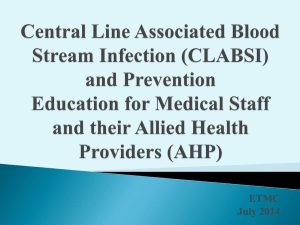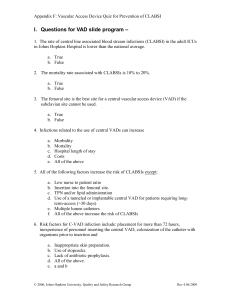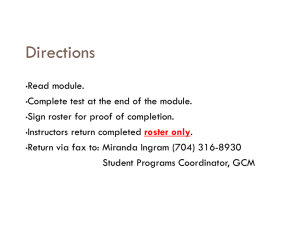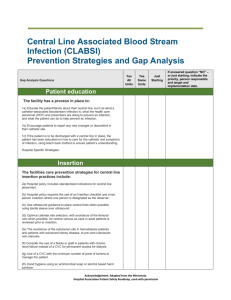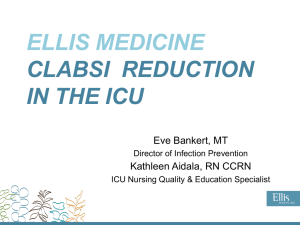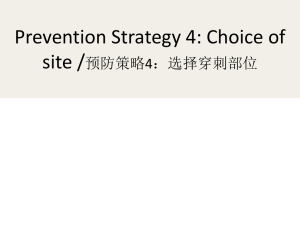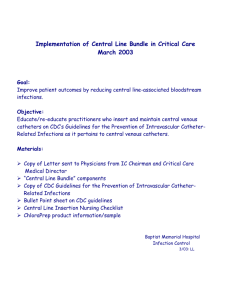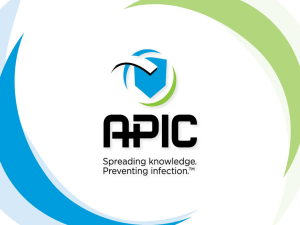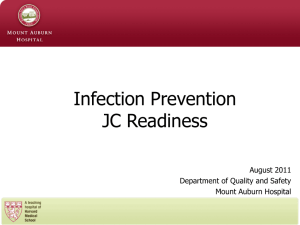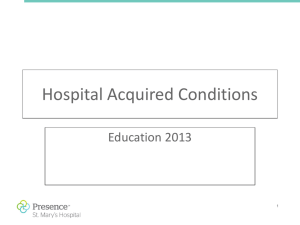CLABSI Module
advertisement
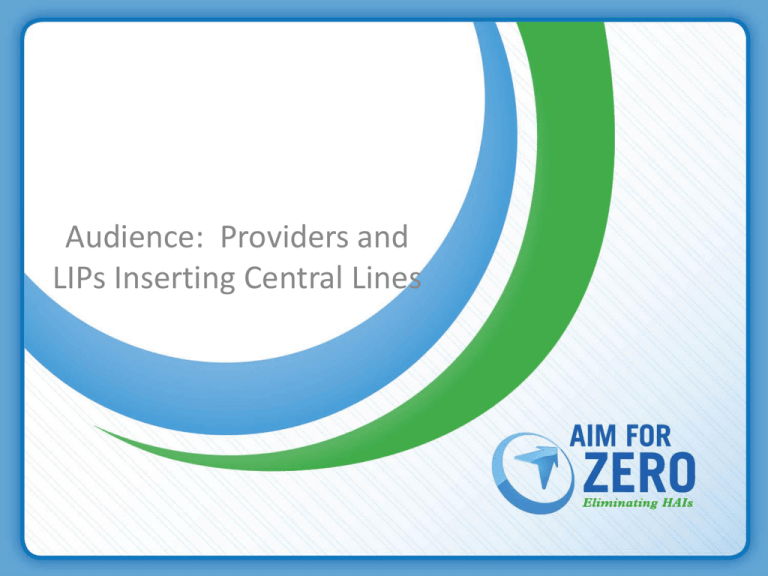
Audience: Providers and LIPs Inserting Central Lines Preventing Central Line Associated Blood Stream Infections (CLABSI) Clinical Services Group The Impact of CLABSI 90% of all catheter related BSIs are associated with central-line catheters •250,000 cases of (CLABSI) annually in the US •80,000 cases occur annually in ICU’s •The attributable mortality of a CLABSI is 12-25% •The attributable cost up to $20,000-$56,000 per episode Mermel LA. Prevention of intravascular catheter-related infections. Ann Intern Med. 2000;132(5):391-402: Maki et al., The risk of bloodstream infection in adults with different intravascular devices: a systematic review of 200 published prospective studies. Mayo Clin Proc. 2006 81(9):1159-71. Dimick J B; et al. Increased resource use associated with catheter-related bloodstream infection in the surgical intensive care unit. Archives of Surgery 2001;136(2):229-34. Why do I need to complete this orientation ? Problem: 1) Vascular access device (VAD) associated infections increase morbidity, mortality, hospital length of stay (LOS) and costs 2) Education of health care workers decreases health care associated infections. Intervention: Mandatory course to achieve standardization of infection prevetion practices during central vascular access device insertion. Outcome: 1) Education in one center1 achieved a 26% relative reduction in central line infections & saved 1.3 million dollars. The same outcomes have been achieved by Johns Hopkins and Keystone2 1 Sheretz et al. Ann Intern Med. 2000;64:1-8 2 Pronovost et al. N Engl J Med 2006; 355:2752-32 Safe Practice Check Central catheter insertions are invasive procedures. They require procedure time-outs.* *elective insertion Rules for Conducting a Procedure “Time Out” • Everyone stops. The time out is given the full attention of all participants. • Include the patient, if possible • A time out is done even if there is only one person present. • Confirm the following 3 elements against what is noted in the chart: –Correct patient –Correct procedure and evidenced based practices Prior to central line insertion, the time out check should –Correct site include identifying a medical indication if the femoral site is selected. • All participants in the time out state out loud whether they agree or disagree that the 3 elements checked are correct. Everyone should be able to hear everyone else’s response. Resolve any concerns verbalize before proceeding. Team Communication “Err on the Side of Caution” If a deviation from an evidenced-based CLABSI prevention strategy occurs or any element of the time-out is in question, every member of the team is expected to: Speak up State the concern objectively Propose possible solutions All teams members—irrespective of their seniority; status; or position—work cooperatively to: Resolve the concern Ensure every patient receives the safest care Evidence Based Prevention Practices to Prevent Central Line Associated Blood Stream Infections 5 Evidence Based Strategies to Prevent CLABSI •Prevention of CLBSI revolves around 5 best practices. When these interventions are bundled together, they significantly decrease CLBSI. These practices are: 1. Good Hand Hygiene 2. Use of Maximal Barrier Precautions For Insertion 3. Use of Chlorhexidine/alcohol to Prepare Skin 4. Optimal Catheter Site Selection, with Avoidance of the Femoral Vein for Central Venous Access in Adult Patients 5. Daily Review of Line Necessity with Prompt Removal of Unnecessary Lines Warren et al. ICHE 2006:27;662-7 Marschall et al. ICHE 2008:29; 22S-30S Hand Hygiene And What You Need to Know •More than 20 studies (including more than 8 prospective studies) have shown that improvement in hand hygiene compliance significantly decreases nosocomial infection rates (including MRSA transmissions). •Alcohol hand rubs are efficacious and easier to use than soap and water. They have excellent activity against bacteria and fungi, mycobacteria, enveloped viruses, HIV, respiratory viruses) and easier to use in many situations •Hand hygiene is an important first step in preventing CLABSI. Alegranzi and Pittet J Hosp Infect 2009 73:305-315; Backman C et al Am J Infect Control 2008 36 (5):333-48; Clin Infect Dis 1999;29:1287-94; Pittet et al. Lancet 2000;356:1307-1312 Maximal Barrier Precautions Data •3 studies: Maximum barrier precautions- the drape covers the patient from head to foot 1)Mermel1991 Am J Med 91(3B):197S-205S. Prospective, Cross-sectional Study (Swan Ganz Catheters) demonstrated that the risk of infection was 2.2 fold higher when MBP were not used (p=0.03) 2)Raad 1994 Infect Control Hosp Epidemiol 15:231-8. Prospective, Randomized Study (Central Venous Catheters) demonstrated that the risk of infection was 3.3 fold higher when MBP were not used (p=0.03) 3) Lee 2008 Infect Control Hosp Epidemiol 2008;29:947-950 demonstrated that the risk for infection was 5.2 higher when MBP were not used (p=0.02) Maximal Barrier Precautions Operator & supervisor (or anyone at risk for crossing the sterile field: For the Patient •Hand hygiene •Cover patient’s head and •Non-sterile cap and body with a large sterile mask drape •All hair should be under cap (includes beard and mustache) •Mask should cover nose and mouth tightly •Sterile gown •Sterile gloves For the Assistant •Hand hygiene •Non-sterile cap and mask •All hair should be under cap (includes beard and mustache) •Mask should cover nose and mouth tightly •Sterile gown •Sterile gloves Note: people in the same room who are not involved with the procedure (and who are not at risk for crossing the sterile field) do not need to wear maximal barrier precautions CHG/Alcohol Skin Prep Is Best •Skin prep with CHG/alcohol is more effective than with povidone iodine (Betadine) in preventing CLABSI •This meta-analysis found that use of CHG reduced the risk of CLABSI by 49% Chaiyakunapruk N et al. Ann Intern Med. 2002;136:792-801 Aseptic Technique • Prepare skin with Chlorhexidine 2% in 70% isopropyl alcohol. Pinch wings on the “Chloraprep” applicator to pop the ampule. Hold the applicator down to allow the solution to saturate the pad. Press sponge against skin, apply chlorhexidine solution using a back and forth friction scrub for at least 30 seconds. Do not wipe or blot. Allow antiseptic solution time to dry completely before puncturing the site (may take 2 minutes). Choice of Site •The femoral site should be avoided. In a clinical trial of ICU patients randomized to femoral or subclavian lines there were: • Higher rate of infectious complications (colonization and BSI combined) in femoral grp: 19.8% vs 4.5% (p < .001) • Higher rate of thrombotic complications in femoral grp: 21.5% vs. 1.9% (p < .001); complete thrombosis 6% vs 0% • The preferred order of preference: • 1) Subclavian 2) Internal Jugular 3) Femoral Merrer, et al. 2001, JAMA; 286:700-7 Two-Dimensional Ultrasound(US) (Note: This stock picture shows assistants without the best practice personal protective garb consisting of cap, headcover, mask with eye protection and gown US-guided versus Anatomical Landmark BMJ 2003; 327:361-7. – Meta-analysis of 18 RCTs • Failed placement: • Complications: • First attempt failure: • Attempts: • Time: RR 86% RR 57% RR 41% 1.5 69.3( sec) CDC/HICPAC use US guidance to reduce number of cannulation attempts and mechanical complications if technology is available 1B Special Considerations for Site Selection •Other factors to consider in site choice include: Anatomic deformity Presence of coagulopathy - Use a compressible site (e.g., IJ, not SC) Hemodialysis patient • National Kidney Foundation 2000 Guidelines recommended against the use of the subclavian vein for any central line unless use of the IJ vein is absolutely contraindicated due to the risk of subclavian vein stenosis. If the IJ vein is chosen, use the right side to reduce risk of mechanical complications. Post Insertion Care • Antimicrobial ointments do not reduce the incidence of CLABSI except HD catheters • Apply a sterile dressing to the insertion site before the sterile barriers are removed. • Transparent dressings are preferred to allow visualization of the site. • If the insertion site is oozing, apply a gauze dressing instead of a transparent dressing. • Replace dressings when the dressing becomes damp, loosened, soiled or after lifting the dressing to inspect the site. Daily Review of Medical Necessity • Evaluate medical necessity of intravenous catheters daily with the patient care team • The care team understands and communicates the reason for the central line • Remove intravenous catheters as soon as possible to reduce the risk of catheter related bloodstream infections. Central Line Guidewire Exchange –Guidewire exchange is acceptable for: • Replacing a malfunctioning catheter • Changing a multi-lumen to a single lumen catheter • Exchanging a pulmonary artery catheter for a central venous catheter • Clinically stable patients with suspected CLABSI and limited venous access – The catheter tip should be cultured and blood cultures sent. If CLABSI is confirmed, the line must be removed. –Guidewire exchange is not allowed in the presence of a tunnel or exit site infection Mermel et al. Clinical Infectious Diseases, 2009; 49:1-45. Technique for Guidewire Exchange • Follow same procedures for insertion of new catheter • Remember to switch to a new set of sterile gloves prior to handling the new catheter (this can be accomplish by putting on two pairs of sterile gloves prior to procedure start). 22 Summary: Preventing CLABSI Key Points Correct indication Correct site - try and avoid femoral insertion Correct skin preparation - use CHG/alcohol Correct compliance with best practice •Hand hygiene •Maximum barrier Correct reason for line continuation Correct communication with team to assure compliance with all of above When CLABSI is Suspected: – If the patient is septic and CLABSI is strongly suspected to be the source, remove the catheter. – Perform appropriate cultures – Document results based on either IDSA criteria or NHSN criteria 24 Central Line Cultures Suspected CLABSI: Method #1 (IDSA) • Remove all dressings and cap off all hubs/ports, then paint the site with antiseptic solution, and include within the sterile field. • Remove line en-bloc. Under no circumstance should catheters be cut prior to removal. • Remove the catheter aseptically, avoiding contact with the patient’s skin and catheter tray. • Use sterile scissors to cut a 5cm segment, including the tip and place it into a culture container and promptly send to micro. • Semiquantitative culture of catheter tips is usually performed by rolling the tip across an agar plate; the presence of >15 colonies along with the same organism isolated from peripheral blood with clinical signs and symptoms and no other recognized source is consistent with a CLABSI. – Comment: A positive catheter tip by itself is not diagnostic for a CLABSI; Do not routinely culture catheter tips on removal unless there are clinical signs and symptoms for infection. Central Line Cultures: Method #2 (IDSA) • For suspected CLABSI draw one set through device and one set from a separate venipuncture. Blood cultures from both line and venipuncture must be positive for same organism with clinical signs and symptoms and no other recognized source. A positive culture from the line only is probably a contaminant and should not be treated. • Alternative: • Time to detection: Differential period of central line culture versus peripheral blood culture positivity > 2 hours (must be equal volumes) • Simultaneous quantitative blood cultures with a ≥5:1 ratio central line versus peripheral blood culture • Draw 2 separate venipuncture blood cultures-see NHSN criteria 26 CDC/HNSN Criteria • Criteria 1: Patient has a recognized pathogen cultured from one or more blood cultures (at least one bottle), and organism cultured is not related to another site of infection. Recognized pathogen excludes organisms considered common skin contaminants • Criteria 2: Patient has at least 1 of the following signs or symptoms: fever (>38oC), chills or hypotension AND signs and symptoms and positive laboratory results are not related to an infection at another site AND common skin contaminant is cultured from 2 or more blood cultures (at least one bottle from each set) drawn on separate occasions within two days of each other.
